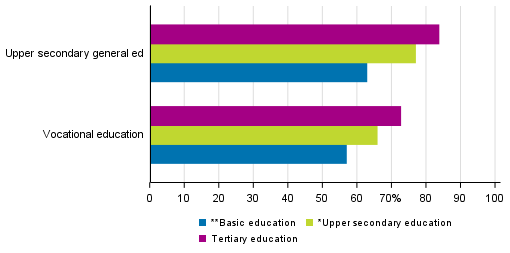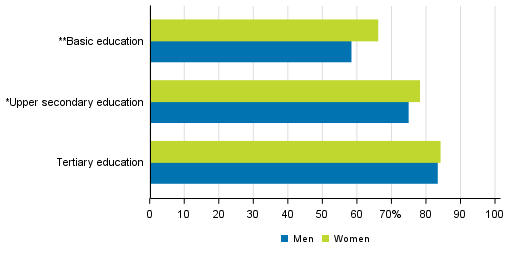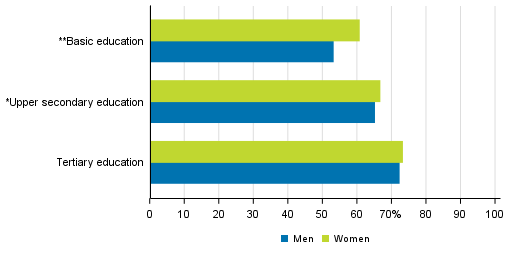Published: 14 March 2019
Parents’ educational background connected to passing upper secondary level education
According to Statistics Finland’s education statistics, children of parents with high education pass upper secondary general school education and upper secondary vocational education faster than students whose parents have completed upper secondary level qualifications or have no post-comprehensive level qualifications. Parents’ high education improved the probability of both daughters and sons passing through education in the target time. Human capital inherited from home had more effect on boys than girls passing through education. Completion of degrees in both university education and university of applied sciences education accelerated.
Pass rates by sector of education and parents’ educational background 2017

** Including persons with unknown educational attainment in Statistics Finland’s education registers
* Including Post-secondary non-tertiary education
Parents’ educational background had an effect on both passing upper secondary level education and entrance to education. In all, 74 per cent of new students in upper secondary general school education and 42 per cent in initial vocational education were children of highly educated parents. Twenty-four per cent of new students in upper secondary general education came from families where the highest qualification was an upper secondary level qualification, while the corresponding share in initial vocational education was 48 per cent. Two per cent of new students in upper secondary general education and 10 per cent of new students in initial vocational education came from families where parents did not have a post-comprehensive level qualification. New students who came from families with low education were a heterogeneous group: 50 per cent of new students in upper secondary general school education and 46 per cent of new students in initial vocational education spoke other than Finnish, Swedish or Sami as their native language. Foreign-language speakers were first or second generation immigrants, on whose parents’ qualifications there is, as a rule, no information in Statistics Finland's Register of Completed Education and Degrees, in which case they are recorded as attainers of post-comprehensive level qualifications.
Upper secondary level education was passed in the target time of three-and a-half years best by children of parents with high education. Differences in the pass rates were big in both upper secondary general school education and initial vocational education depending on parents’ educational background. Eighty-four per cent of children of parents with high education passed the matriculation examination in the target time and 73 per cent of those having started studies for an initial vocational qualification. In all, 77 per cent of children of parents with upper secondary level qualifications passed the matriculation examination in the target time and 66 per cent of those having started studies for an initial vocational qualification. Of children of parents with no post-comprehensive level qualifications, 63 per cent passed the matriculation examination in the target time and 57 per cent of those having started studies for an initial vocational qualification.
Pass rates of upper secondary general education by gender and parents’ educational attainment 2017

** Including persons with unknown educational attainment in Statistics Finland’s education registers
* Including Post-secondary non-tertiary education
According to the data for 2017, upper secondary general education was completed typically in 3.5 to 4.5 years: Eighty-two per cent of new students in upper secondary general schools completed the upper secondary general school syllabus in at most three-and-a-half years and 89 per cent in at most four-and-a-half years. Men studying in upper secondary general school passed their qualifications slightly slower than women studying there did.
Parents’ educational background had an effect on the pass rates of both women and men, although the effect on sons’ passing education was slightly higher. Eighty-four per cent of daughters of parents with high education passed the matriculation examination in the target time and 83 per cent of sons, whereby the difference between the pass rates was one percentage point. When parents’ highest qualification was an upper secondary level qualification, sons' pass rate fell to 75 per cent and daughters’ to 78 per cent, in which case the pass rates differed by three percentage points. The difference between the genders in the pass rates was biggest in the case of parents with low level of education: 58 per cent of men passed the qualification in the target time and 66 per cent of women, where the difference between the pass rates was eight percentage points. The pass rate of men coming from families with high education was 25 percentage points higher than the pass rate of men from families with low education. The corresponding difference for women was 18 percentage points.
Pass rates of upper secondary vocational education by gender and parents’ educational attainment 2017

** Including persons with unknown educational attainment in Statistics Finland’s education registers
* Including Post-secondary non-tertiary education
Sixty-eight per cent of students attending vocational education aimed at young people completed a qualification in three-and-a-half years and 75 per cent at most in four-and-a-half years. Women completed a qualification slightly faster than men.
Of daughters of parents with high education, 73 per cent completed an initial vocational qualification in the target time and 72 per cent of sons. The difference between the pass rates was one percentage point. Of sons of parents with upper secondary level qualifications, 65 per cent completed a qualification and 67 per cent of daughters, in which case the difference between the pass rates was two percentage points. Fifty-three per cent of sons of parents without a post-comprehensive level qualification completed a qualification in the target time and 61 per cent of daughters, in which case the difference between the pass rates was eight percentage points. The pass rate of men coming from families with high education was 19 percentage points higher than the pass rate of men from families with low education. The corresponding difference for women was 12 percentage points.
Fifty-one per cent of those who started studying for a university of applied sciences degree completed their studies in four-and-a-half years. Of men, 35 per cent completed a qualification in the target time and 64 per cent of women, so the difference between the pass rates was 19 percentage points.
The pass rate of university education grows, the longer time has passed from the start of education. The older the cohort of new students is examined, the higher the pass rate became. Sixty-three per cent of students completed a lower or higher university degree in five-and-a-half years and as many as 72 per cent of those having studied for 7.5 years had passed a university degree. Of women, 69 per cent completed their degree in five-and-a-half years, while the figure for men was 55 per cent.
The database tables of these statistics contain information on the differences between the pass rates for different sectors of education (see database tables ). The database tables also include information on those students who did not attain their qualification in the target time.
More information related to the progress of studies is available from statistics describing: ( Discontinuation of education , Employment of students ).
Source: Education Statistics, Statistics Finland
Inquiries: Mika Witting 029 551 3530, koulutustilastot@stat.fi
Director in charge: Jari Tarkoma
Publication in pdf-format (262.6 kB)
- Tables
-
Tables in databases
Pick the data you need into tables, view the data as graphs, or download the data for your use.
Appendix tables
- Appendix table 1. Progress of new upper secondary school students (aimed at young people) studies by end 2017 (14.3.2019)
- Appendix table 2. Progress of new students studies in vocational education (aimed at young people) by end 2017 (14.3.2019)
- Appendix table 3. Progress of new university of applied sciences students studies by end 2017, youth education (14.3.2019)
- Appendix table 4. Progress of new university students studies by end 2017, lower or higher university degrees (14.3.2019)
Updated 14.3.2019
Official Statistics of Finland (OSF):
Progress of studies [e-publication].
ISSN=1799-1021. 2019. Helsinki: Statistics Finland [referred: 19.12.2025].
Access method: http://stat.fi/til/opku/2019/opku_2019_2019-03-14_tie_001_en.html

